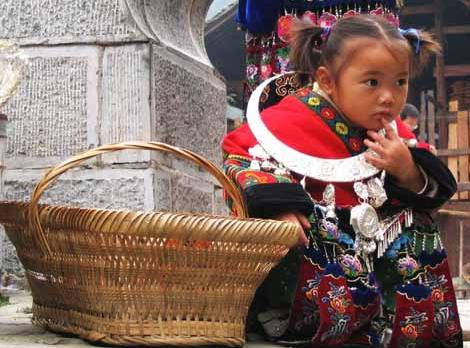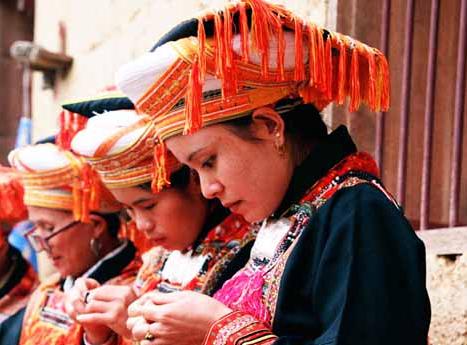
With a population of 2,637,421 in the year 2000, the Yao ethnic minority is a typical nationality living in the mountainous regions of the southern part of China. Their main habitats are Hunan, Yunnan, Guangdong, Guizhou, and Jiangxi together with Guangxi Zhuang Autonomous Prefecture. They are divided into several branches, such as Baiku Yao (the Yao people who wear white trousers), Hong Yao (the Yao people who favor red clothes), and so on.
Similar to the other 54 ethnic groups of China, the Yao ethnic minority has its unique religious and cultural characteristics.
Language:
The Yao language belongs to the Miao-Yao sub-group of the Sino-Tibetan language family. Most of the Yao people speak the Yao language, some speak a language similar to the Miao language, and a few even use the Zhuang and Dong languages. Their language differs so much between regions that people from different areas have difficulty communicating with each other. They can also speak Han and Zhuang languages. As to the written characters of Yao language, Nv Shu (a special written language in South China used only by women), are used by Yao women. Han characters are widely used among Yao people, but written words of Yao language were created by Central University for Nationalities in 1982. Thus, the written words of Yao are also used universally now.

Religion:
The Yao people living in different regions have differing beliefs. Some of them worship nature, some idolize their ancestors, and some adore the totem. Taoism (one of the accepted Chinese religions) also plays an important role in the life of the Yao people, which includes the following of sacrificial ceremonies. Some Yao people believe in wizardry.
Food:
The staple foods of the Yao people are rice, corn and potatoes. Most of the meat in their diet comes from their own domestic livestock and from wild animals that the men hunt. Teas and homemade wines are their favorite drinks. As the Yao people are very hospitable and polite, they entertain guests with their palatable food and refined wines and insist that seniors be seated in the seat of honor.

The Yao minority group holds many festivals, with at least one a month. Among the grand festivals, Panwang festival and Danu festival are the ones most worth mentioning. The former is held either every year, or every three to five years to express their reverence for their earliest known ancestor, Panwang. During this festival, everyone dresses themselves in their finest clothing and festively sings and dances to heart's content.
Other culture and arts of the Yao ethnic minority are also worth appreciating, such as the ballads and legends with rich content and multiple styles that depict the nation's history, glorify the hard revolutions, or express their sweet love, with their distinctive music and songs as tambourine dance and timbal dance.
All in all, the moralities of diligence, faithfulness, hospitality, and braveness have been handed down from generation to generation among the Yao ethnic minority, and have become the representative characteristics of the Yao people.





